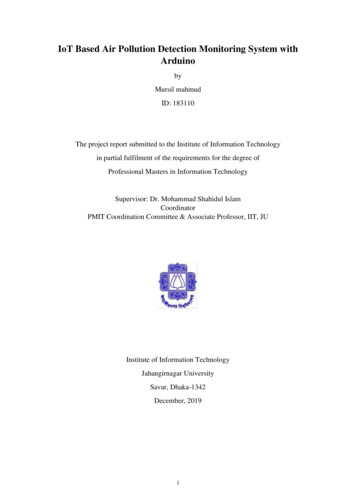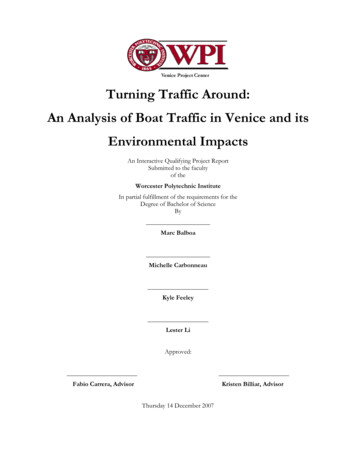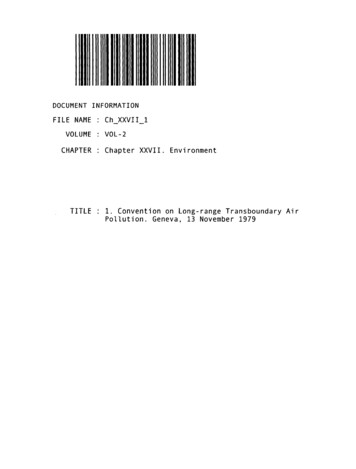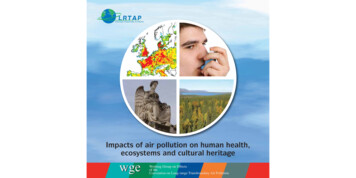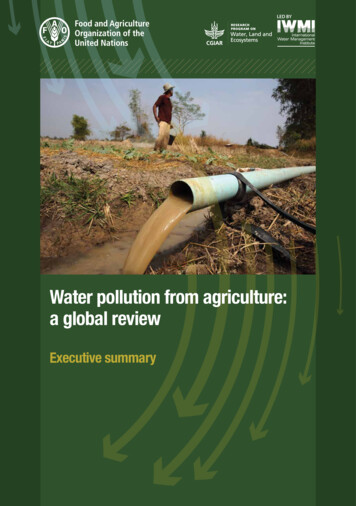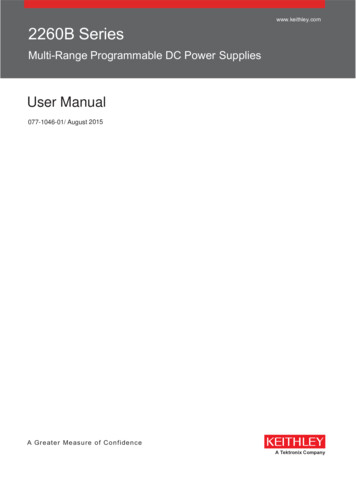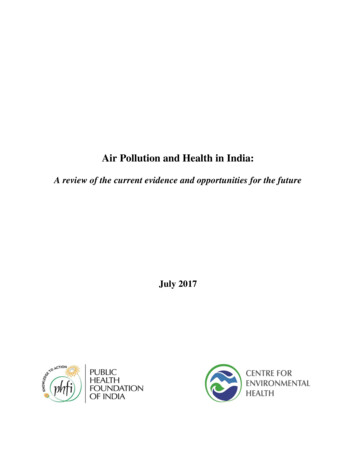
Transcription
Air Pollution and Health in India:A review of the current evidence and opportunities for the futureJuly 2017
Table of Contents1. Introduction . 91.1 Methodology . 112. Air Pollution Exposure & Trends . 122.1 Household air pollution. 122.1.1 Activity based exposures . 122.1.2 Rural-urban heterogeneity. 142.1.3 Spatial heterogeneity . 152.1.4 Impact of socio-economic status . 162.2 Ambient air pollution . 162.2.1 Monitoring by government agencies. 172.2.2 PM levels: current scenario and regional variations . 172.2.3 Trends over time . 192.2.4 Rural-urban heterogeneity. 202.2.5 Projections going forward . 213. Health Impacts . 223.1 Health impacts of exposure to air pollution in India . 223.2 Evidence for policy . 263.3 Strengthening the evidence base . 274. Barriers to Change . 324.1 Access to quality health outcome data and HMIS issues . 324.1.1 Health outcome data . 324.1.2 Public sources . 33Page 2 of 64
4.1.2.1 Health Management Information System . 334.1.2.2 Surveys . 334.1.3 Databases . 344.1.3.1 Civil Registration System . 344.1.3.2 Integrated Disease Surveillance Programme (IDSP) . 344.1.3.3 Disease registries (Cancer, Stroke and Cardiac events) . 344.1.4 New initiatives . 344.1.5 Private sources . 354.1.5.1 Hospital-based data . 354.1.6 Quality and Utility of Health Data . 354.2 Access and quality of air pollution data . 364.2.1 Household air pollution – data sources . 374.2.2 Ambient air pollution – data sources . 374.2.2.1 Monitoring by Government Agencies. 374.2.3 Low-cost monitoring networks . 384.2.4 Quality of data. 394.3 Awareness of health risks of air pollution exposure . 415. Conclusions and Way Forward . 445.1 Leveraging existing resources to carry out large scale health impact studies . 445.2 Impact evaluation of policy interventions . 455.3 Low-cost monitoring & citizen science for data collection . 455.4 Localized evidence generation . 465.5 Awareness generation through strategic communications . 485.6 Governance and evidence for effective policymaking . 49BibliographyPage 3 of 64
List of TablesTable 1: Cooking time indoor TSP, PM10, PM2.5 levels with the usage of biomass, dung cakes, and LPG asdomestic fuelsTable 2: Estimated premature mortality due to ambient air pollution in IndiaTable 3: Major health studies in India for HAP related burden assessmentsTable 4: Percentage of total DALYs and risk factor attribution to air pollution in BRICS countriesTable 5: Analysis of CPCB & DPCC data for missing data points (2010-2016)List of FiguresFigure 1: Proportions of usage of various domestic fuels in rural and urban IndiaFigure 2: 24 hr averaged PM2.5 kitchen concentrations in IndiaFigure 3: Indian states with online monitoring stationsFigure 4: PM2.5 variations over IndiaFigure 5: Increase in PM2.5 concentrations between 2001-2010Page 4 of 64
List of AbbreviationsDALYs – Disability Adjusted Life-YearsGBD – Global Burden of DiseasePM – Particulate MatterGDP – Gross Domestic ProductLPG – Liquefied Petroleum GasHAP – Household Air PollutionVOC – Volatile Organic CompoundsPAH – Polyaromatic HydrocarbonsCO – Carbon monoxideSOx – oxides of SulphurNOx – oxides of NitrogenEC – Elemental CarbonOC – Organic CarbonTSP – Total Suspended ParticlesRSPM – Respirable Suspended Particulate MatterETS - Environmental Tobacco SmokeIGP – Indo-Gangetic plainAAP – Ambient Air PollutionWHO – World Health OrganisationNAAQS – National Ambient Air Quality StandardsNAMP - National Air Quality Monitoring ProgrammeCPCB - Central Pollution Control BoardCAAQMS - Continuous Ambient Air Quality Monitoring StationsACRB – Agriculture Crop Residue BurningUSEPA – United States Environmental Protection AgencyALRI - Acute Lower Respiratory InfectionsHEI – Health Effects InstituteIHME – Institute for Health Metrics and EvaluationPage 5 of 64
IIT – Indian Institute of TechnologyPAPA – Public Health and Air Pollution in AsiaTB – TuberculosisCOPD - Chronic Obstructive Pulmonary DiseaseCVD – Cardiovascular diseaseSDG – Sustainable Development GoalsNRHM – National Rural Health MissionNHM – National Health MissionHMIS - Health Management Information SystemCHC – Community Health CentresNIMHANS - National Institute of Mental Health and Neuro-SciencesNFHS - National Family Health SurveyDLHS - District Level Household SurveyAHS – Annual Health SurveyNMHS – National Mental Health SurveyHIV – Human Immunodeficiency VirusRCH – Reproductive and Child HealthMCCD - Medical Certification of Cause of DeathIDSP - Integrated Disease Surveillance ProgrammeICMR – Indian Council for Medical ResearchPBCRs - Population Based Cancer RegistriesHBCRs - Hospital Based Cancer RegistriesEHR - Electronic Health RecordsIHIP - Integrated Health Information PlatformMCH – Maternal and Child HealthICD – International Statistical Classification of Diseases and Related Health ProblemsUT – Union TerritoryLMIC - low and middle-income countryLC – Low CostDPCC – Delhi Pollution Control CommitteePage 6 of 64
EPIC - Energy Policy Institute at University of ChicagoCEEW - Council on Energy, Environment and WaterMPCB - Maharashtra Pollution Control BoardSAFAR - System of Air Quality and Weather Forecasting and ResearchMSW – Municipal Solid WasteCLAIM - Clean Air India MovementAQI - National Air Quality IndexPIL - Public Interest LitigationCEPI - Comprehensive Environmental Pollution IndexASHA – Accredited Social Health ActivistNSSO – National Statistical Survey OrganisationPage 7 of 64
1. IntroductionAir pollution is a major and growing risk factor for ill health in India, contributing significantly to thecountry’s burden of disease. As per the Global Burden of Disease comparative risk assessment for 2015,air pollution exposure contributes to approximately 1.8 million premature deaths and 49 million disabilityadjusted life-years (DALYs) lost, ranking it among the top risk factors for ill health in India. Home to 10of the top 20 cities with the highest annual average levels of PM2.5 as per the WHO Urban Ambient AirQuality Database (2016)1, and with several studies showing a worsening trend over time2,3, it is safe to saythat rapid urbanization and industrial development have adversely affected urban air quality due tovehicular and industrial emissions. Simultaneously, over two-thirds of rural Indians caught in the ‘chulhatrap’ use biomass fuels such as wood, dung or coal to satisfy their cooking and heating needs, resulting insmoke-filled homes and extremely high levels of exposure especially to women and children.Rural and urban India are both affected by poor air quality. There is, however, heterogeneity in sources andpollutant profiles. For instance, use of cooking fuels varies between urban and rural households, vehiculardensity is vastly different in cities and villages, and differing climatology and geography across India affectsregional and seasonal levels of ambient air pollution.Air pollution has been termed a democratizing force4 but it is far from that, as it propagates existingenvironmental injustices. Studies have shown that children and the elderly are particularly vulnerable to airpollution exposure. Air pollution exposure has shown to slow lung development in children 5, affectcognitive development6, and has resulted in high levels of mortality from respiratory infections7. The elderlyare more likely to develop chronic respiratory and cardiac illnesses as a result of long-term exposure, andare more susceptible to heart attacks and strokes during episodic high pollution events. Vulnerable also arethose of a lower socio-economic status, with studies showing they are more susceptible to insults from airpollution exposure for a variety of reasons including occupation, housing, cooking fuel use, the commonlink being poverty8.While environment, health and development are frequently pitted in adversarial roles in the discourse oneconomic growth, published evidence argues that they are very much in consonance. A study published bythe World Bank9 in 2016 revealed that air pollution cost India approximately 8% of its GDP or 560 billionin 2013, as a result of lost productivity due to premature mortality and morbidity. This study, while a greatfirst step, failed to capture the healthcare costs of treating air pollution-induced illnesses, which if factoredin, could produce a far larger number.To address the multi-dimensional, multi-sectoral problem of air pollution requires a cogent and consideredapproach that takes into account the best available epidemiological evidence, benefit-cost analyses ofPage 8 of 64
various interventions, and a strong communications platform to ensure broad awareness of the healthimpacts of air pollution and the advantages of mitigation. The review carried out for this report however,shows us that there is a dearth of work carried out in all of the areas mentioned above.While the epidemiological evidence for the health impacts of air pollution in India is strong, strengtheningit in several aspects as outlined in this report would aid in more informed policymaking. There arechallenges however that preclude high quality research on the health effects of air pollution from beingconducted in India, and many of these have to do with the quality and the availability of air quality andhealth outcome data. At the moment, the health evidence base on air pollution is primarily based on crosssectional or time-series studies which have been conducted in large cities through primary research.Challenges remain in conducting such studies with secondary data due to (a) the availability of qualityhealth outcome data from the public and private sector, thwarted by the poor uptake of any standardizedelectronic health records framework, and (b) the sparse coverage and questionable quality of air qualitydata collected by government agencies. This lack of data also ensures that there remain challenges inconducting long-term studies on the health impacts of air pollution (particularly ambient), since thehistorical records of air quality data in most cities (particularly PM2.5) go back only a few years, with manymissing data points.While the research evidence base needs to be strengthened further, there have been some significantdevelopments in the policy space, recognizing that the evidence necessary to develop policy is alreadythere. The Union Ministry of Health & Family Welfare in 2014 constituted a Steering Committee of expertson air pollution, with the report of this committee released in late 2015/early 2016. The Committee’s Reporton Air Pollution and Health Related Issues10 outlined targeted actions to improve health outcomesassociated with air pollution by moving beyond air quality management. Following this, there have beensome concrete policy actions including improving rural LPG access through the Pradhan Mantri UjjwalaYojana. The establishment of a Standing Committee on Air Pollution, proposed to be chaired by the Health& Environment Secretaries, is under consideration at the ministerial level. However, most action on airpollution is often driven by the judiciary, with the National Green Tribunal and the Supreme Court takingthe lead. The directives from the Judiciary have led to the fast-tracking of newer fuel and emissionsstandards for vehicles, and a focus on reducing air pollution during episodic events such as Diwali. Suchdecision-making, however, is often characterized by a lack of in-depth understanding of the health impactsand a focus on short-term solutions without a larger vision to improve air quality.The purpose of this analytical white paper is to identify effects of health concerns for air pollution ongovernment and public actions in India, identify barriers and opportunities; and propose recommendationson how to use heath concerns to build support for air pollution control and prevention. Given the status ofPage 9 of 64
the evidence and the challenges outlined, the authors still believe that much can be done to (a) documentthe health impacts of air pollution; (b) engage diverse stakeholder groups to call for multi-sectoral action;(c) raise awareness especially amongst vulnerable populations; and (d) carry out impact evaluations. Thisdiversity of sources and drivers ensures that a Pan-India policy to achieve the National Ambient Air QualityStandards (NAAQS) has till date been unarticulated. What can drive this, however, is the localization ofevidence, broadening awareness of the health impacts, and ensuring that accountability is at the heart ofpolicymaking.1.1 MethodologyA structured review of available literature on air pollution and health in India was conducted. This involvedsearching for articles and reports on online databases such as PubMed as well as resources from ministrywebsites. To supplement findings from the literature reviewed, a stakeholder consultation was undertaken,and some secondary data analysis was conducted. A questionnaire survey was developed and disseminatedamong stakeholders with expertise in the areas of air pollution and associated health impacts, includingenvironmental health researchers, physicians, and ministry officials. These expert stakeholders wereidentified through purposive sampling and were contacted via email. Some were followed up with in-personat the National Consultation on Environmental Health, hosted by the Centre for Environmental Health (towhich the authors are affiliated), held on June 5th 2017 at New Delhi. Inputs from group discussions heldat the consultation are also factored into this report. Further details of experts consulted and thequestionnaire tool are attached in Annexures. The report was reviewed by two internal and two externalreviewers before submission.Page 10 of 64
2. Air Pollution Exposure & TrendsAir quality, whether ambient or household, differs across India, with varied sources, pollutants,climatology, geography, and cultures. Over time, however, trends indicate deterioration in both urban andrural India, whether it is due to rapid urbanization and consequent rising vehicular and industrial emissionsor the ‘chulha trap’ resulting in poor indoor air quality.2.1 Household air pollutionIndividuals spend close to three-fourths of their day (around 18 hours) in indoor environments, whichinclude residences and workplaces11. Indoor activities such as cooking, heating, cleaning, incense burning,tobacco smoking, refrigeration, and air conditioning are significant contributors of air pollutantsemissions11–15. The infiltration of ambient air into indoor environments through ventilation intakes, doorsand windows also result in household air pollution (HAP)16. Fine and ultrafine particulates, biologicalaerosols, volatile organic compounds (VOCs), poly aromatic hydrocarbons (PAHs), carbon monoxide(CO), oxides of sulphur and nitrogen (SOx and NOx) are typically found indoors in households wherebiomass is used for cooking or heating17–19. In the following sections, exposures associated with indoorpollution, their spatial heterogeneity and urban-rural differences in the Indian subcontinent will be outlined.2.1.1 Activity based exposuresCooking and heating: Biomass combustion, involved in cooking and heating practices, is the principalsource of HAP in India19. Close to 60% of Indian households use biomass (in the form of firewood, charcoal,manure, and crop residues) as their main energy source for cooking, while around 30% use LPG20. Morethan 250 teragrams (Tg) of biomass is estimated to be used annually for cooking activities in India, resultingin significant emissions of pollutants such as PM, elemental and organic carbon (EC and OC), CO, NO2,VOCs, and PAHs21–23.In India, women spend close to 1.7-2.4 hours/day for cooking, while men spend around 0.08-0.1 hours/dayin the vicinity of a kitchen13. Total suspended particles (TSP) exposures during cooking are reported to beas high as 7000 µg/m3, while respirable suspended particulate matter (RSPM) exposures are reported to bein the range of 500-2,000 µg/m3, 13,24. Results from a large cohort study (N 3000) in Nepal indicate 24 houraverage indoor PM2.5 levels as high as 1400 µg/m3 in households with biomass usage for heating andcooking activities25. Studies have found sizeable differences in diurnal averaged PM levels betweenhouseholds using cleaner cooking fuels like LPG (75 μg/m3) and dirty fuels like biomass ( 360 μg/m3)13 inindoor living areas. Table 1 shows typical indoor pollutant levels reported in India under usage of variousdomestic fuels.Page 11 of 64
ionConcentration (μg/m3)CookingSmith et al.(1983)GujaratWoodKitchenperiodTSP6400(45 min)MenonPradesh,(1988)2000 P(2 hours)PM10KitchenParikh et al.(2001)BiomassTamil Naduand LPGKitchen,MealLivingdurationroom(2 MadhyaBalakrishnanet al.(2013)Pradesh, TamilNadu,Biomass,Dungcake,Uttaranchal,West Bengaland LPGKitchen,LivingLivingroom59024 hBiomass157roomDung cake741190179LPG95Table 1. Cooking time indoor TSP, PM10, PM2.5 levels with the usage of biomass, dung cakes, andLPG as domestic fuelsIncense and tobacco burning: Incense burning emits significant quantities of fine particulate matter(PM2.5), CO, NOx, PAHs, and VOCs26–28. The duration of burning typically ranges between 5-45 minutesPage 12 of 64
in indoor environments. Particulate emissions from incense burning ( 50 mg/g) are found 5 times higherthan due to cigarette smoking (10 mg/g) 11,29,30. Goel et al. (2017)11 observed PM10 levels elevate to 2500µg/m3 inside sanctums of Kanpur temples during incense burning. About 75-90% of PM10 mass is found tobe contributed by particles less than 2.5 µm which indicate significant emissions of fine and ultrafineparticulate matter from incense burning.Environmental tobacco smoke (ETS) also contributes significantly to HAP in India 31. Tobacco smokecontains over 4000 chemicals, including at least 70 carcinogens, released whenever a tobacco product issmoked. Tobacco smoking can increase indoor PM2.5 levels by 400-500%32. A study carried out in indoorenvironments of pubs and restaurants of Mumbai reported a drastic increase in PM 2.5 levels from 240.8μg/m3 to 669.95 μg/m3 post introduction of indoor smoking32.2.1.2 Rural-urban heterogeneityHAP sources differ between rural and urban locations31. More than 89% of the rural Indian population relieson biomass for cooking purposes whereas urban India mostly uses LPG (65%) 20. Indoor emissions fromthe domestic sector are therefore more significant in rural rather than urban India. In contrast, the infiltratedambient pollution fraction into indoor environments are higher in cities than villages. This is due to higheron-road vehicular density, which contributes larger quantities of air pollution emissions 31. The diurnalaveraged RSPM levels were reported to be as high as 350 µg/m3 in typical Indian rural households wherebiomass is used as a domestic fuel. Rural households using LPG for domestic activities are observed tohave lower HAP levels ( 75 µg/m3) than urban houses using LPG ( 135 µg/m3), indicating a largercontribution of ambient sources to indoor exposures in Indian urban areas13,33. Figure 1 shows thedistribution of various domestic fuels in urban and rural India.Kerosene7%DungCake1%others coke8%2%LPG64%Firechips18%URBANPage 13 of 64
6%RURALFigure 1. Proportions of usage of various domestic fuels in rural and urban India(Source: Census of India 201120)2.1.3 Spatial HeterogeneityDiverse climatology, geography, population, culture and fuel usage21,34,35 generate varying indoor airquality across India, as shown in modelled average indoor PM2.5 concentrations based on quantitative airpollution measurements in 4 Indian states. Higher indoor PM2.5 concentrations (in the kitchen area) areobserved in north Indian states in the Indo-Gangetic Plain (IGP) i.e. Uttar Pradesh (UP), Delhi, Punjab, andHaryana (557-601 μg/m3), while lower concentrations are observed in southern states such as Kerala,Karnataka, Tamil Nadu, and Andhra Pradesh (183-214 μg/m3). Higher concentrations in northern states inthe IGP are attributed to extensive usage of dung cakes for cooking activities and biomass for heatingactivities due to cold winters22. Figure 2 shows the model estimated spatial variation of kitchen PM2.5concentrations across India.Page 14 of 64
Figure 2. 24 hr averaged PM2.5 kitchen concentrations in India(Source: Balakrishnan et al., 2014)2.1.4 Impact of socio-economic statusExposure to air pollution is dependent on socio-economic and socio-cultural differences31. A majority ofurban slums in India are located close to factories and highways. Therefore, people residing in slums aremore prone to higher exposures from industrial and vehicular emissions36,37. Densely populated localitieswith absent exhaust vents, coupled with the use of low quality domestic fuels (such as biomass, dung etc.),and the presence of unpaved roads further deteriorates indoor air in slums31,36. A study carried out byKulshreshtha et al. (2008)38 identified differences of 110-175 µg/m3 in indoor PM concentrations betweenlow and high income houses. Another study carried out in Mumbai also reported higher indoor pollutantconcentrations in low income houses than affluent ones39.2.2 Ambient air pollutionAmong major health risk factors in India, ambient air pollution (AAP) is ranked 5th in mortality and 7th inoverall health burden. According to the World Health Organisation (WHO), 10 of the 20 most pollutedcities in the world are in India, including Delhi, Patna, Gwalior, Raipur etc.1 PM levels often exceed theNational Ambient Air Quality Standards (NAAQS) in more than three-fourths of Indian cities2. The primaryPM sources in India are emissions from industries, power plants, vehicles, construction activities, biomassPage 15 of 64
combustion for domestic activities, and waste burning31,40–43. These sources are widely varied across thecountry.2.2.1 Monitoring by government agenciesAmbient air quality monitoring in India is largely focused in urban areas, with a limited coverage in itsrural locations3,44. The National Air quality Monitoring Programme (NAMP) is a nation-wide campaignlaunched by India’s Central Pollution Control Board (CPCB) to monitor primary pollutants (SO2, NO2,PM10 and PM2.5) levels in urban and semi-urban areas45. Under NAMP, CPCB operates more than 629monitoring stations in 264 Indian cities and towns46 and provides pollutants data from the late 1980s.Further, CPCB also operates 60 continuous ambient air quality monitoring stations (CAAQMS) in 35major cities of 14 Indian states (Figure 3). Apart from the primary air pollutants listed above, pollutantssuch as Benzene, Ozone, and PAHs are also monitored real time in CAAQMS stations 47. CPCB startedcommissioning CAAQMS stations from 2008 onwards, and by 2015, it completed setting up stations in allits target cities. In addition, several state-level pollution regulatory authorities also monitor primarypollutants levels in various urban and industrial locations within their respective states.Figure 3. Indian states with online monitoring stations (circular indicators are provided over thestates) (Source: CPCB, 2017)2.2.2 PM levels: current scenario and regional variationsPM2.5 levels are in excess of the WHO annual standard of 10 μg/m3 in over 70% of the Indian subcontinent.The present Indian annual standard for PM2.5 (40 μg/m3) set by CPCB is in between WHO’s Interim targets2 and 3. Recent studies have shown, through a combination of ground monitoring and satellite data, thatPage 16 of 64
the annual averaged PM2.5 levels in the Indian subcontinent are in the range of 10-100 µg/m3 3,31. Higherconcentrations are observed over north Indian cities, while lower concentrations were observed over southIndian rural locations31,48. Among metro cities, New Delhi, Kolkata, Mumbai, and Hyderabad have thehighest PM2.5 levels (annual average concentrations: 40-81 µg/m3) and exceed the prescribed permissiblestandards (40 µg/m3); Chennai has the lowest PM2.5 levels ( 25 µg/m3)a. Diurnal averaged PM2.5 levels overDelhi and Kolkata are recorded as high as 300 µg/m3, higher than the CPCB permissible standard of 60µg/m349,50. Further, diurnal averaged PM2.5 levels in Tier 2 north and central Indian cities such as Agra,Kanpur, Raipur and rural locations of the IGP are on par with levels over major Indian cities such as Delhiand Kolkata31,51.As discussed, India exhibits a wide spatial heterogeneity in air pollution. Major Indian metro cities andregions in the IGP have been identified as critically polluted areas31. The concentrations over these locationsare found to be at least 2-4 fold higher than levels over southern India (Figure 4). Colder winters, whichnecessitate the extensive use of biomass and coal for cooking and heating activities, and the presence of alarge number of brick kilns ( 65% of total 100,000 kilns across India) with inferior technology result inhigher pollutant concentrations over the IGP52. In addition, shallow mixing heights and low wind speedscauses low atmospheric dilution rates over the IGP region than the rest of India. This results in poordispersion of pollutants which further enhances pollutants levels53.Figure 4. PM2.5 variations over IndiabaBased on data analysis of PM2.5 concentrations measured
Page 4 of 64 List of Tables Table 1: Cooking time indoor TSP, PM 10, PM 2.5 levels with the usage of biomass, dung cakes, and LPG as domestic fuels Table 2: Estimated premature mortality due to ambient air pollution in India
